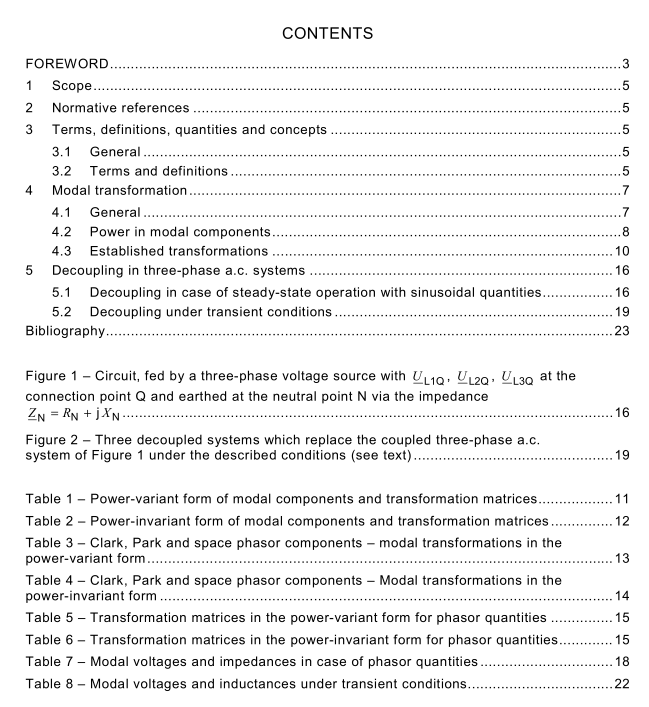IEC 62428 pdf – Electric power engineering – Modal components in three-phase a.c. systems – Quantities and transformations

IEC 62428 pdf – Electric power engineering – Modal components in three-phase a.c. systems – Quantities and transformations
This International Standard deals with transformations from original quantities into modalquantities for the widely used three-phase a.c. systems in the field of electric powerengineering.
The examination of operating conditions and transient phenomena in three-phase a.c.systems becomes more difficult by the resistive,inductive or capacitive coupling between thephase elements and line conductors. Calculation and description of these phenomena inthree-phase a.c. systems are easier if the quantities of the coupled phase elements and lineconductors are transformed into modal quantities. The calculation becomes very easy if thetransformation leads to decoupled modal systems. The original impedance and admittancematrices are transformed to modal impedance and admittance matrices. ln the case ofdecoupling of the modal quantities,the modal impedance and admittance matrices becomediagonal matrices.
2Normative references
The following referenced documents are indispensable for the application of this document.For dated references,only the edition cited applies.For undated references, the latest editionof the referenced document (including any amendments) applies.
IEC 60050-141,International Electrotechnical Vocabulary (IEV) – Part 141: Polyphasesystems and circuits
3Terms, definitions, quantities and concepts
3.1General
Quantities in this standard are usually time-dependent. These quantities are for instanceelectric currents, voltages, linked fluxes,current linkages, electric and magnetic fluxes.
For quantities the general letter symbol g in case of real instantaneous values, g in case ofcomplex instantaneous values and G in case of phasors (complex r.m.s. values) are used.
NOTE Complex quantities in this standard are underlined.Conjugated complex quantities are indicated by anadditional asterisk (*). Matrices and column vectors are printed in bold face type,italic.
3.2Terms and definitions
For the purposes of this document, the terms and definitions given in lEC 60050-141 and thefollowing apply.
3.2.1
original quantities
quantities g or G of a three-phase a.c. system
NOTESubscripts 1,2, 3 are generally used in this standard; additional letters may be put, for instance L1,L2,L3as established in lEC 60909.IEC 60865 and lEC61660.
3.2.2
modal components
quantities gM.g or CM found by a transformation from the original quantities according toClause 3
NOTE Additional subscripts 1,2,3 are used.3.2.3
column vector of quantities
column matrix containing the three original quantities or modal components of a three-phasea.c. system
NOTE Column vectors are described by g or gand G or Gw. respectively.
3.2.4
modal transformation
matrix equation T gM = g for a column vector gw containing the three unknown modalquantities, where g is a column vector containing the three given original quantities and T is a3×3 transformation matrix
NOTE The transformation can be power-variant or power-invariant, see Tables 1 and 2.3.2.5
inverse modal transformation
solution gM = ‘ g of the modal transformation that expresses a column vector gw containingthe three modal quantities as a matrix product of the inverse transformation matrix T’ by acolumn vector g containing the three original quantities
3.2.6
transformation into symmetrical componentsFortescue transformation
linear modal transformation with constant complex coefficients, the solution of which convertsthe three original phasors of a three-phase a.c. system into the reference phasors of threesymmetric three-phase a.c. systems — the so-called symmetrical components — , the firstsystem being a positive-sequence system,the second system being a negative-sequencesystem and the third system being a zero-sequence system
NOTE1 The transformation into symmetrical components is used for example for the description of asymmetricsteady-state conditions in three-phase a.c. systems.
NOTE 2 See Tables 1 and 2.
3.2.7
transformation into space phasor components
linear modal transformation with constant or angle-dependent coefficients, the solution ofwhich replaces the instantaneous original quantities of a three-phase a.c. system by thecomplex space phasor in a rotating or a non-rotating frame of reference,its conjugatecomplex value and the real zero-sequence component
NOTE 1 The term “space vector” is also used for “space phasor”.
NOTE 2 The space phasor transformation is used for example for the description of transients in three-phase a.c.systems and machines.
NOTE 3 See Tables 1 and 2.









